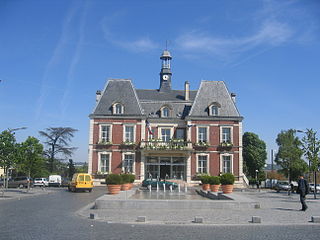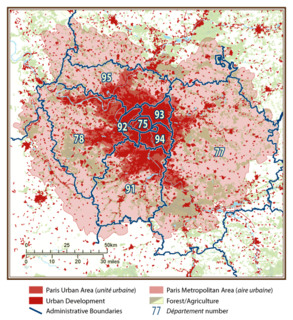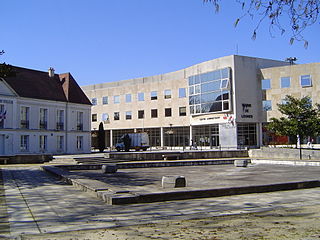
The 13th arrondissement of Paris is one of the 20 arrondissements of the capital city of France. In spoken French, this arrondissement is referred to as treizième.

Vitry-sur-Seine is a commune in the southeastern suburbs of Paris, France. It is located 7.5 km (4.7 mi) from the centre of Paris.

Noisy-le-Grand is a commune in the eastern suburbs of Paris, France. It is located 15.2 km (9.4 mi) from the centre of Paris. The commune of Noisy-le-Grand is part of the sector of Porte de Paris, one of the four sectors of the "new town" of Marne-la-Vallée.

Chinatowns in Europe include several urban Chinatowns that exist in major European capital cities. There is a Chinatown in London, England, as well as major Chinatowns in Manchester, Birmingham, Newcastle and Liverpool. In Paris there are two Chinatowns: one where many Vietnamese – specifically ethnic Chinese refugees from Vietnam – have settled in the Quartier chinois in the 13th arrondissement of Paris which is Europe's largest Chinatown, and the other in Belleville in the northeast of Paris. Berlin, Germany has two Chinatowns, one in the East and one in the West. Antwerp, Belgium also has an upstart Chinese community.

Cambodia is the smallest of the three Francophone communities in Southeast Asia, the others being found in Vietnam and Laos. Out of all Asian Francophone nations, Cambodia is where French has declined the most. In 2014, French was spoken by 423,000 people as a foreign language, which is 3% of the country's population and by only 873 people as a mother tongue according to the country's 2008 census.

Khmer people are one of the Cambodian ethnic group and nation native to Cambodia, accounting for over 97% of the country's 15.9 million people. They speak the Khmer language, which is part of the larger Austroasiatic language family found in parts of Southeast Asia, parts of central, eastern, and northeastern India, parts of Bangladesh in South Asia, in parts of Southern China and numerous islands in the Indian Ocean.

The city of Paris had a population of 2,187,526 people within its administrative city limits as of January 1, 2017. It is surrounded by the Paris unité urbaine, or urban area, the most populous urban area in the European Union. In 2017 the unité urbaine had a population of 10,784,830. The Paris Region, or Île-de-France covers 12,012 square kilometers, and has its own regional council and president. It has a population of 12,174,880 as of January 2017, or 18.3 percent of the population of France.

Marne-la-Vallée is a new town located near Paris, France.
Cambodians in France consist of ethnic Khmer people who were born in or immigrated to France. The population as of 2020 was estimated to be about 80,000, making the community one of the largest in the Cambodian diaspora. The Cambodian population in France is the most established outside Southeast Asia, with a presence dating to well before the Vietnam War and subsequent Indochina refugee crisis.

Lognes is a community in the eastern suburbs of Paris, France. It is located in the Seine-et-Marne department in the Île-de-France 20.7 km (12.9 mi) from the center of Paris.

Noisiel is a commune in the French department of Seine-et-Marne, administrative region of Île-de-France, France. It is located in the eastern suburbs of Paris, 20.5 km (12.7 mi) from the center of Paris.

The largest of the ethnic groups in Cambodia are the Khmer, who comprise approximately 90% of the total population and primarily inhabit the lowland Mekong subregion and the central plains. The Khmer historically have lived near the lower Mekong River in a contiguous arc that runs from the southern Khorat Plateau where modern-day Thailand, Laos and Cambodia meet in the northeast, stretching southwest through the lands surrounding Tonle Sap lake to the Cardamom Mountains, then continues back southeast to the mouth of the Mekong River in southeastern Vietnam.
The Chinese diaspora in France consists of people of Chinese ancestry who were born in or immigrated to France. The population of the community is estimated to be about 600,000, making it the largest Asian community in the country. Though they form a small part of the overseas Chinese population, the Chinese diaspora of France represents the largest overseas Chinese community in Europe.

Laos is a Buddhist-majority nation with the officially recognised Muslim population approximately constituting 0.01% of the total population as of 2008 census. The majority of Laotian Muslims are Sunni. Laotian Muslims can be found in the capital, Vientiane, which has two mosques, as well as other urban areas such as Savannakhet and Oudomxay; the latter of which had a mosque constructed there in June 2016. Laotian Muslims are an ethnically diverse group, mainly consisting of ethnic Lao, Chin Haw, Chams, Tamils and Pashtuns, with interracial marriages being increasingly popular. They are generally engaged in trade, agriculture, cosmetics, clothing and business though some have attained official roles with the government.
Asian diasporas in France consist of foreign residents and French citizens originating from Asian countries living in France. French citizens of Asian descent primarily have ancestry from the former French colonies of Indochina, although there has been a growing number of Chinese and Turkish immigration to France. Other Asian ethnic groups found in France include other West Asians, such as the Lebanese, South Asians, Japanese and Koreans.
The Laotian diaspora consists of roughly 800,000 people, both descendants of early emigrants from Laos, as well as more recent refugees who escaped the country following its communist takeover as a result of the Laotian Civil War. The overwhelming majority of overseas Laotians live in just three countries: Thailand, the United States, and France.

The Indochina refugee crisis was the large outflow of people from the former French colonies of Indochina, comprising the countries of Vietnam, Cambodia, and Laos, after communist governments were established in 1975. Over the next 25 years and out of a total Indochinese population in 1975 of 56 million, more than 3 million people would undertake the dangerous journey to become refugees in other countries of Southeast Asia, Hong Kong, or China. According to the United Nations High Commissioner for Refugees, 250,000 Vietnamese refugees had perished at sea by July 1986. More than 2.5 million Indochinese were resettled, mostly in North America, Australia, and Europe. More than 525,000 were repatriated, either voluntarily or involuntarily, mainly from Cambodia.

The Quartier Asiatique, also called Triangle de Choisy or Petite Asie is the largest commercial and cultural center for the Asian community of Paris. It is located in the southeast of the 13th arrondissement in an area that contains many high-rise apartment buildings. Despite its status as a "Chinatown", the neighborhood also contains significant Vietnamese, Laotian and Cambodian populations.

Paris is home to the oldest Overseas Vietnamese community in the Western world and is also one of the largest outside Vietnam. There are an estimated 70,000 people of Vietnamese descent within the city limits of Paris as of 2018, with the greater Île-de-France area home to another estimated 100,000. Both figures make the Paris metropolitan area host to one of the greatest concentrations of Vietnamese outside Vietnam, if not the largest.
Chinese prostitution in Paris has developed since the late 1990s. Prostitutes of Chinese origin work mainly on the streets of some neighbourhoods, where they are nicknamed les marcheuses, but also in massage parlours or through the internet. In 2016, Médecins du Monde estimated that there were 1,450 Chinese prostitutes in Paris.



















